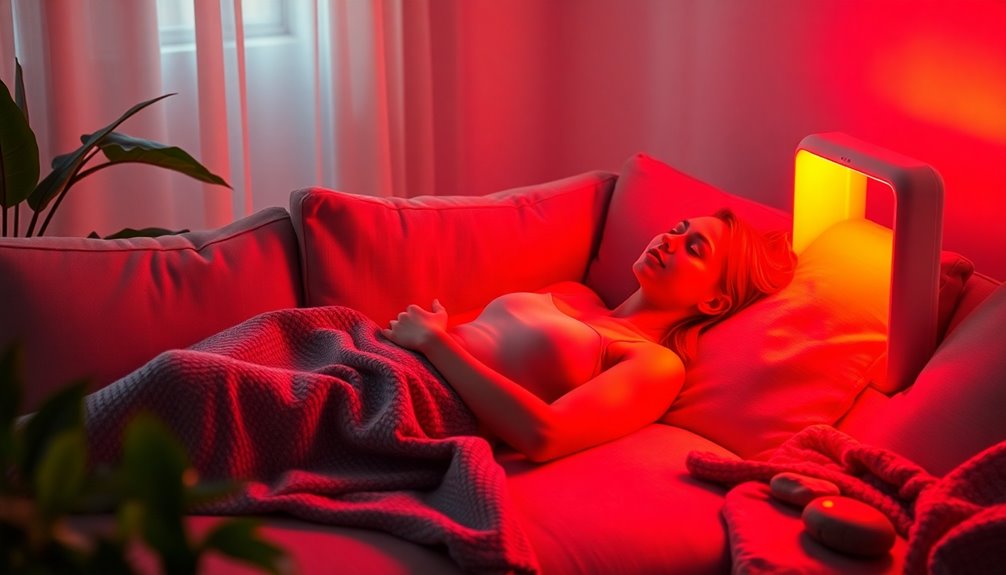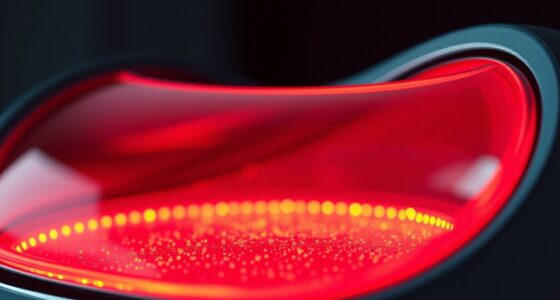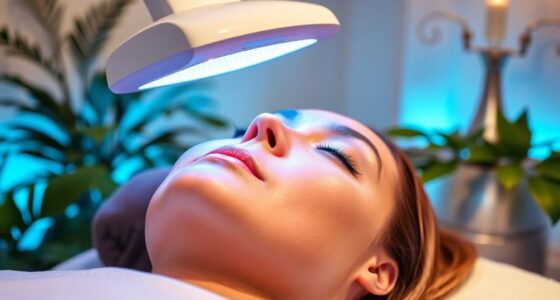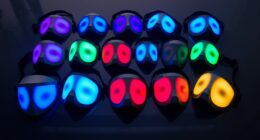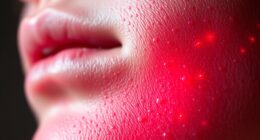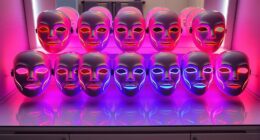Light therapy is a powerful tool for reducing inflammation, helping you tackle chronic pain and health issues effectively. It works by reducing pro-inflammatory cytokines while boosting anti-inflammatory ones, which can ease symptoms like pain and swelling. You can choose from various devices, like LED red light for surface issues or infrared for deeper tissue. Research backs up its effectiveness in treating post-surgical inflammation and even conditions like psoriasis. Plus, combining light therapy with exercise or other treatments enhances your recovery. There's a lot more to discover about this innovative approach, so keep exploring to unlock its full potential.
Key Takeaways
- Light therapy reduces pro-inflammatory cytokines while increasing anti-inflammatory cytokines, helping to alleviate inflammation.
- Utilizing red and infrared light in the optimal wavelength range enhances cellular energy and supports recovery from inflammation.
- Evidence shows light therapy effectively reduces inflammation in conditions like psoriasis and post-surgical recovery.
- Combining light therapy with exercise can further improve recovery and reduce muscle soreness.
- Tailoring light therapy with other treatments, like facials or medications, can maximize anti-inflammatory benefits.
Understanding Inflammation
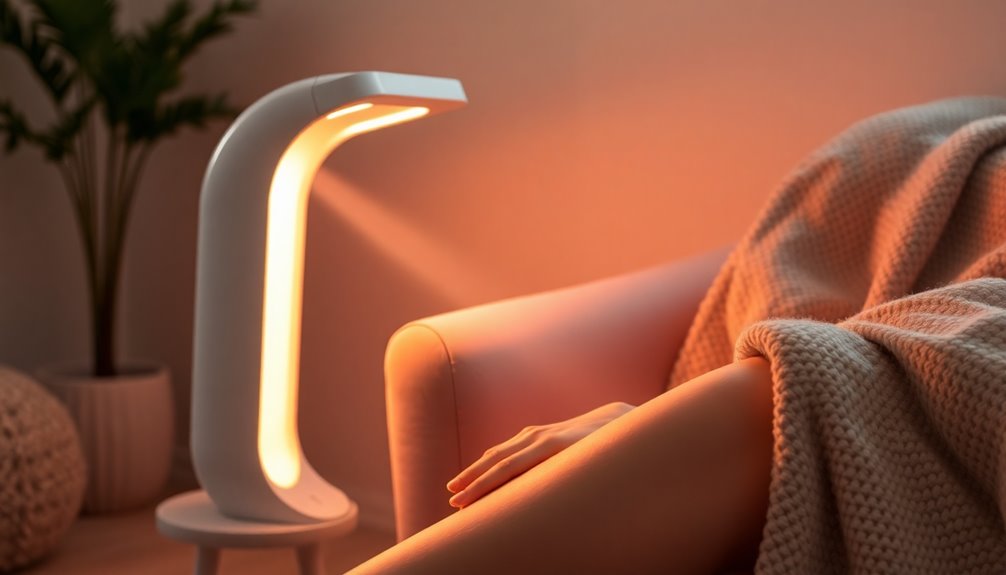
When you think about inflammation, it's important to recognize that it can be both a protective response and a potential problem.
Acute inflammation helps your body fight injury and infection, but chronic inflammation can arise from harmful substances, poor diet, and lifestyle factors like stress and inactivity. This persistent state can lead to serious health issues, including cardiovascular disease and joint pain. Chronic inflammation can also contribute to mental health conditions such as depression and anxiety.
Autoimmune diseases also contribute to inflammation, affecting conditions like rheumatoid arthritis and lupus.
Symptoms you might experience include pain, swelling, and digestive issues. Understanding the causes and effects of inflammation is crucial for managing your health and preventing chronic diseases.
Adopting healthier habits can significantly improve your inflammatory response and overall well-being.
Mechanism of Light Therapy
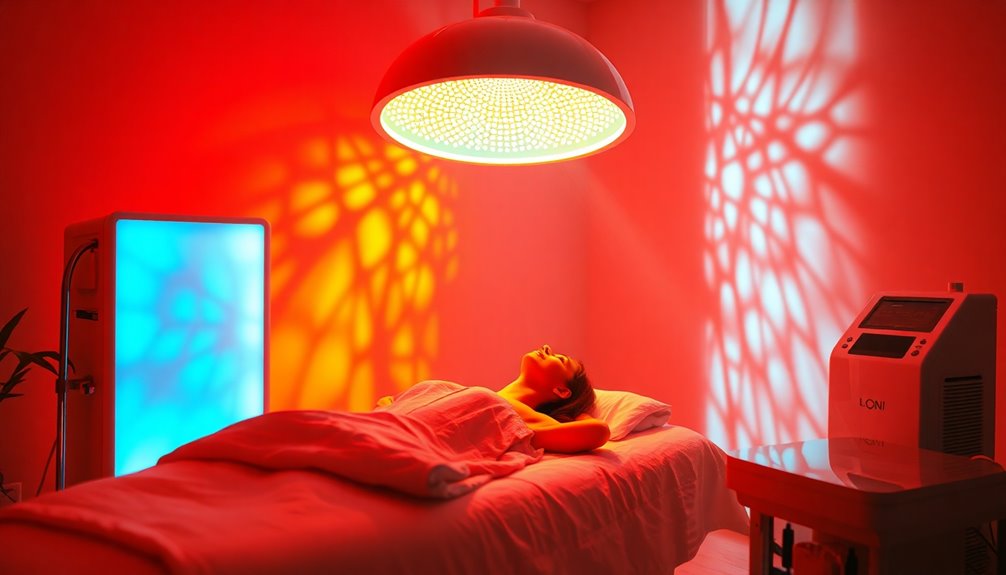
Light therapy operates through several key mechanisms that help reduce inflammation and promote healing.
First, it decreases pro-inflammatory cytokine production, notably TNF-α and IL-1β, leading to reduced inflammation at the cellular level. Simultaneously, it boosts anti-inflammatory cytokine production, particularly IL-10, which counters pro-inflammatory effects and balances the inflammatory response.
Additionally, light therapy enhances cellular repair and regeneration by stimulating mitochondrial activity, increasing ATP production, and accelerating tissue healing. Recent studies have shown that light therapy can effectively decrease oxidative stress in various cell types, further supporting its role in inflammation reduction.
It also modulates oxidative stress by reducing reactive oxygen species and upregulating antioxidant defenses.
This combination of effects optimizes cellular health, improves energy levels, and supports overall recovery, making light therapy a powerful tool in reducing inflammation effectively.
Choosing the Right Device
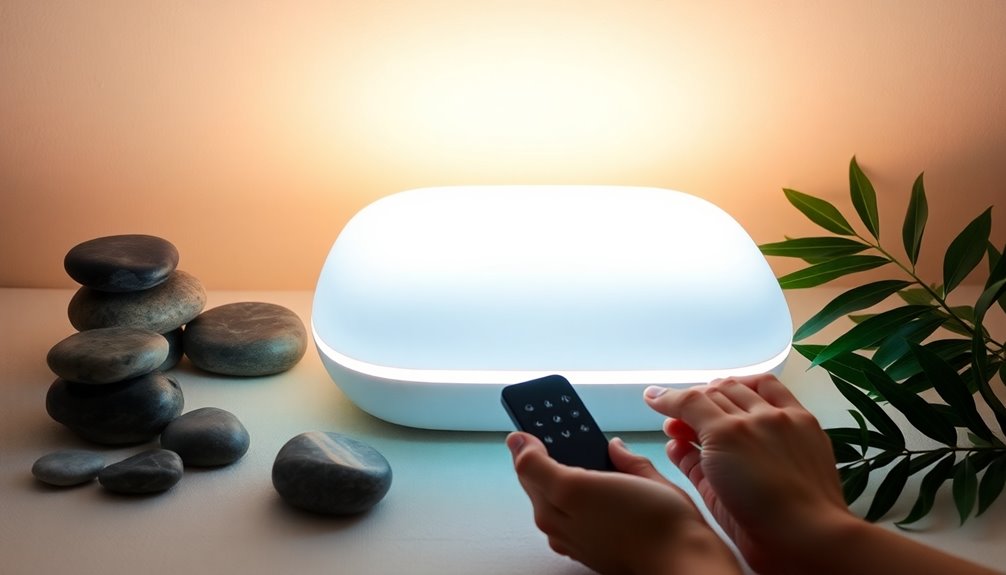
Selecting the right light therapy device is crucial for effectively reducing inflammation and promoting healing. You have several options to consider, like LED red light therapy for superficial issues and infrared light therapy for deeper tissue concerns. If you want versatility, multi-wavelength devices combine both red and near-infrared light for broader applications. Think about location-specific devices, like knee wraps or shoulder wraps, for targeted treatment.
Make sure the device emits light in the optimal range—between 600-700nm for red and 800-900nm for near-infrared—while mimicking sun intensity around 24 mW/cm². Light therapy is effective in reducing inflammation at a cellular level, which can enhance the overall benefits of your treatment. Additionally, incorporating diversification in your health regimen can further support overall wellness and recovery.
Finally, consider additional features such as low-angle emission LEDs and compact designs for ease of use. Choose wisely to maximize your healing potential.
Clinical Evidence
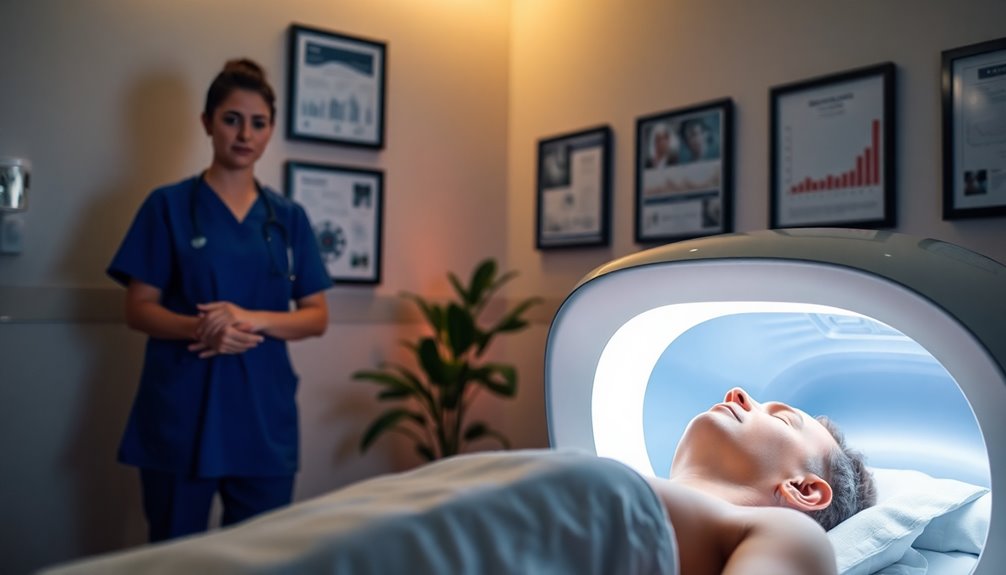
As you explore the benefits of light therapy for reducing inflammation, it's essential to consider the clinical evidence backing its effectiveness. Research shows that light therapy decreases pro-inflammatory cytokines like TNF-α while increasing anti-inflammatory cytokines such as IL-10.
It stimulates cellular processes through specific wavelengths, reducing oxidative stress and activating protective cellular mechanisms. Clinical trials reveal that light therapy effectively reduces post-surgical inflammation, muscle soreness, and oral inflammation. It has also demonstrated therapeutic potential in managing disease severity in conditions like psoriasis. Notably, patients with vitamin D deficiency respond better to light therapy, highlighting its importance in inflammation management.
This growing body of evidence underscores light therapy as a promising strategy for inflammation reduction, particularly as PBM promotes neurogenesis and further aids in combating inflammation-related conditions.
Combining With Other Therapies
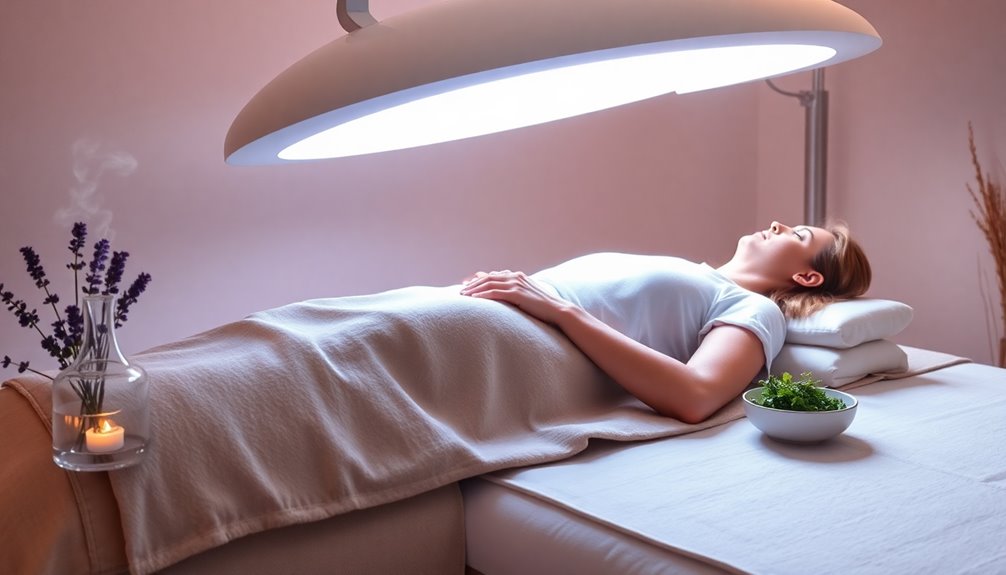
When exploring the benefits of light therapy, combining it with other therapies can enhance overall results.
For instance, pairing red light therapy with exercise not only reduces muscle fatigue but also speeds up recovery, helping you perform better and prevent injuries. Additionally, this combination helps enhance muscle endurance, allowing you to push through tougher workouts.
If you're into skin care, incorporating light therapy with facials can reduce inflammation and improve the absorption of moisturizers, addressing multiple skin concerns at once. This can be particularly beneficial for those dealing with emotional instability, as stress can exacerbate skin issues.
Additionally, combining UV light therapy with topical or oral medications can significantly boost skin healing.
Lastly, if you're undergoing physical therapy, Neurocare Light Therapy can enhance circulation and reduce pain, promoting nerve regeneration.
These combinations create a tailored approach that maximizes benefits and supports your specific health goals.
Potential Applications
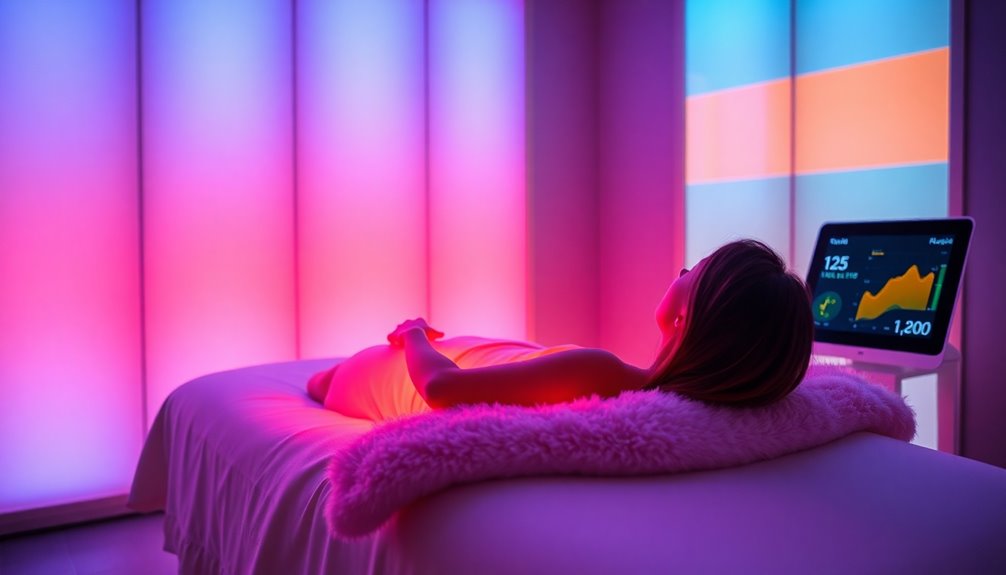
Light therapy offers a variety of potential applications that can significantly enhance health and well-being. One notable treatment gaining traction is led light therapy for hyperpigmentation, which targets dark spots and uneven skin tone through specific wavelengths of light. By promoting cellular regeneration and reducing melanin production, this therapy not only improves skin appearance but also fosters a renewed sense of confidence in individuals struggling with skin concerns. Additionally, light therapy has been explored for its benefits in mood enhancement and pain relief, further solidifying its role in holistic wellness practices.
For brain disorders, red and near-infrared light therapy reduces neuroinflammation, improving cognitive function and aiding stroke recovery. Additionally, it has been strongly recommended for managing depression symptoms due to its effectiveness in reducing inflammation.
In skin health, it treats acne, psoriasis, and eczema by alleviating inflammation and promoting healing.
When it comes to joint disorders, photobiomodulation (PBM) helps relieve osteoarthritis pain and enhances joint health.
Additionally, PBM shows promise for lung disorders like COPD by modulating inflammatory cytokines.
As research continues, clinical trials demonstrate the effectiveness of light therapy across these diverse areas, making it an exciting option for improving overall health and addressing specific inflammatory conditions.
Frequently Asked Questions
How Often Should I Use Light Therapy for Inflammation?
You should aim to use light therapy for inflammation based on your specific needs.
Generally, start with 10-20 minute sessions, adjusting frequency to 3-5 times a week for general wellness.
If you're targeting pain or injury recovery, you might need daily sessions initially, then reduce to every other day.
Always consider your skin sensitivity and consult a healthcare professional if you have chronic conditions to find the best plan for you.
Are There Any Side Effects of Red Light Therapy?
When diving into the bright world of red light therapy, you might uncover a few shadows lurking around.
Yes, there can be side effects! You could experience headaches, eye strain, or even mild skin irritation.
In rare cases, dryness or skin burns might pop up.
To navigate safely, wear protective goggles, limit your session duration, and consult with a healthcare provider if you have any worries.
Always listen to your body!
Can Light Therapy Be Used on All Body Parts?
Yes, light therapy can be used on all body parts.
You can opt for full-body red light therapy for holistic benefits, like improved sleep and mood, or targeted therapy for specific issues, such as joint pain or skin conditions.
Both methods effectively reduce inflammation and promote healing.
Just make sure to follow proper guidelines for application to maximize effectiveness and ensure safe treatment across different areas of your body.
How Long Do I Need to Use the Device Each Session?
You should aim for red light therapy sessions lasting between 5 to 20 minutes.
Most people find 10 to 20 minutes effective. If you're new to it, start with shorter sessions of 5 to 10 minutes to let your body adapt.
Is Light Therapy Safe for Children and Pregnant Women?
Did you know that light therapy can significantly improve mood and sleep for up to 60% of children?
It's generally safe for both kids and pregnant women. Bright light therapy is non-invasive and can help regulate emotions.
For pregnant women, red light therapy poses no risks, while reducing inflammation and discomfort.
Just remember to consult a healthcare provider to ensure proper usage and monitor any potential reactions. Your safety and health come first!
Conclusion
Incorporating light therapy into your wellness routine can be a game-changer, much like discovering a hidden gem in a well-trodden path. By understanding inflammation and harnessing the power of light, you're not just alleviating discomfort; you're stepping into a brighter, healthier future. Remember, it's not just about the light—it's about the journey towards holistic healing. So why not shine a little light on your health and embrace this innovative approach? Your body will thank you.
